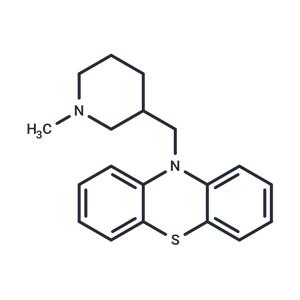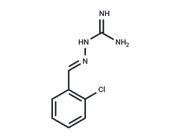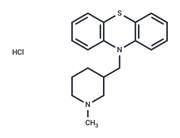| Name | Mepazine |
| Description | Mepazine (Pecazine) is a potent and selective inhibitor of MALT1, inhibiting GSTMALT1 full length and GSTMALT1 325-760 with IC50s of 0.83 μM and 0.42 μM, respectively. Mepazine enhances apoptosis and impacts cell viability. |
| In vitro | Mepazine (5, 10, and 20 μM) decreases cell viability in the ABC-DLBCL cells HBL1, OCI-Ly3, U2932, and TMD8, without significantly affecting GCB-DLBCL cells[1]. |
| In vivo | In female NSG mice with a murine DLBCL xenogeneic tumor model, Mepazine (16 mg/kg; i.p.) interferes with the growth and induces apoptosis of ABC-DLBCL cell line OCI-Ly10. Mepazine strongly impairs the expansion of OCI-Ly10 with daily administration[1]. |
| Storage | Pure form: -20°C for 3 years | In solvent: -80°C for 1 year | Shipping with blue ice/Shipping at ambient temperature. |
| Solubility Information | DMSO : 25 mg/mL (80.53 mM), Sonication is recommended.
|
| Keywords | mucosa associated lymphoid tissue lymphoma translocation gene 1 | Mepazine | MALT1 | lymphoma | large | Inhibitor | inhibit | diffuse | B cell | Apoptosis | ABC-DLBCL |
| Inhibitors Related | Stavudine | 5-Fluorouracil | Flubendazole | Cysteamine hydrochloride | Acetylcysteine | L-Glutamic acid monosodium salt monohydrate | Sodium 4-phenylbutyrate | L-Ascorbic acid | L-Glutamic acid | Tributyrin | L-Ascorbic acid sodium salt | Alginic acid |
| Related Compound Libraries | Apoptosis Compound Library | Bioactive Compound Library | ReFRAME Related Library | Drug-induced Liver Injury (DILI) Compound Library | CNS-Penetrant Compound Library | Inhibitor Library | Immunology/Inflammation Compound Library | Bioactive Compounds Library Max |

 United States
United States






